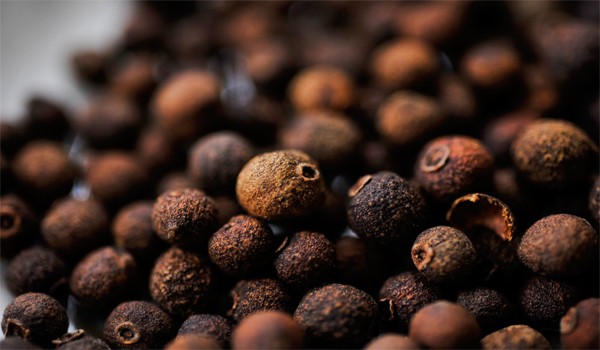
Did you know that this tree got its name when the British couldn’t decide which spice it was, so named it ‘all spice’?
This powerful spice is actually derived from the dried fruit of the pimento tree, which is why it is commonly called Jamaica pepper, pimenta, or pimento. Native to Central America, parts of the Caribbean, and Mexico, the allspice bearing tree is named because of the dried brown berries (which look like large peppercorns), that smell and taste like a mixture of cinnamon, cloves, and nutmeg. The flavour is certainly unique, but what makes this spice even more intriguing is the high concentration of beneficial nutrients and organic compounds, such as eugenol, quercetin, and tannins that result in some impressive health benefits.
These berries, picked when ripe (see image above) and dried in the sun until slightly shriveled (see image below), have numerous health benefits that include the ability to act as a pain reliever, increase circulation, protect the gastrointestinal system, improve mood, boost the immune system, eliminate fungal infections, lower blood pressure and reduce inflammation.
One of the most celebrated aspects of allspice is its ability to lower inflammation and alleviate pain in parts of the body. The active ingredients in the spice have chemical compounds that eliminate inflammation, making it an ideal spice to give you some relief from arthritis, gout and muscle aches. It also has certain analgesic components that allow for pain reduction in the case of injury or surgical recovery.
The calming, rubefacient effects of allspice’s organic components make it perfect for soothing the stomach. The eugenol found in allspice can eliminate digestive issues such as diarrhea, nausea, vomiting, and constipation, while also stimulating regularity, which reduces bloating and excess flatulence. The anti-inflammatory aspect of allspice further eases cramps.
Research has shown certain antibacterial and antifungal effects of allspice, particularly in terms of stomach bacteria (E. coli and Listeria monocytogenes). In addition to helping the gastrointestinal system function smoothly, it also protects it from outside attack through a natural immune response. Furthermore, when allspice is added to certain foods, it can neutralise the bacteria at that level, before it ever enters your body to begin doing damage.
The presence of eugenol, quercetin, tannins, and other chemical compounds makes allspice a very potent antioxidant, as many of those substances are perfect for neutralising free radicals and eliminating them from the body. Free radicals are the harmful byproducts of cellular metabolism that can cause healthy cells to mutate, often leading to serious diseases – even cancer. The high level of vitamin C and vitamin A present in allspice also contribute to this antioxidant activity.
The antimicrobial, antibacterial, and antiseptic aspects of allspice can help to boost your dental health; although gargling with this spice wouldn’t be particularly pleasant, it has been connected to healthier dental and gum health by protecting against bacterial pathogens.
With significant levels of copper and iron, allspice is ideal for boosting circulation, as these are essential components of red blood cells. Furthermore, the rubefacient aspect of the spice is a stimulant and warms the body. Combined with increased blood flow, this can result in additional energy and the proper oxygenation of extremities in the body. Iron also functions in the creation of certain enzymes that are crucial for overall metabolism.
The potassium found in allspice has a positive effect on heart health, as it is a vasodilator and releases much of the tension on the cardiovascular system. This causes an increase in blood flow through the relaxed blood vessels and reduces the strain on the arteries and heart, thereby lowering the chances of developing atherosclerosis, and subsequently, strokes and heart attacks.
Keep an eye out for pimento on the seasonal Brasserie menu!


